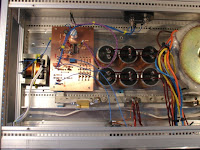Variable RF attenuators are often used to control the level of a radio frequency signal using a control voltage in RF design. These variable RF attenuators can even be used in programmable RF attenuators. Here the known voltage generated by a computer for example can be applied to the circuit and in this way create a programmable RF attenuator.
Often when designing or using variable or programmable RF attenuators, it is necessary to ensure that the RF attenuator retains a constant impedance over its operating range to ensure the correct operation of the interfacing circuitry. This RF attenuator circuit shown below provides a good match to 50 ohms over its operating range.
RF attenuator circuit description
The PIN diode variable attenuator is used to give attenuation over a range of about 20 dB and can be used in 50 ohm systems. The inductor L1 along with the capacitors C4 and C5 are included to prevent signal leakage from D1 to D2 that would impair the performance of the circuit.
The maximum attenuation is achieved when Vin is at a minimum. At this point current from the supply V+ turns the diodes D1 and D2 on effectively shorting the signal to ground. D3 is then reverse biased. When Vin is increased the diodes D1 and D2 become reverse biased, and D3 becomes forward biased, allowing the signal to pass through the circuit.
Typical values for the variable RF attenuator circuit might be: +V : 5 volts; Vin : 0 - 6 volts; D1 to D3 HP5082-3080 PIN diodes; R1 2k2; R2 : 1k; R3 2k7; L1 is self resonant above the operating frequency, but sufficient to give isolation between the diodes D1 and D2.
These values are only a starting point for an experimental design, and are only provided as such. The circuit may not be suitable in all instances.
Choice of PIN diode
Although in theory any diode could be used in variable RF attenuators, PIN diodes have a number of advantages. In the first place they are more linear than ordinary PN junction diodes. This means that in their action as a radio frequency switch they do not create as many spurious products and additionally as an attenuator they have a more useful curve. Secondly when reverse biased and switched off, the depletion layer is wider than with an ordinary diode and this provides for greater isolation when switching or providing higher levels of attenuation.
Source: PIN diode variable RF attenuator circuit
Often when designing or using variable or programmable RF attenuators, it is necessary to ensure that the RF attenuator retains a constant impedance over its operating range to ensure the correct operation of the interfacing circuitry. This RF attenuator circuit shown below provides a good match to 50 ohms over its operating range.
RF attenuator circuit description
The PIN diode variable attenuator is used to give attenuation over a range of about 20 dB and can be used in 50 ohm systems. The inductor L1 along with the capacitors C4 and C5 are included to prevent signal leakage from D1 to D2 that would impair the performance of the circuit.
The maximum attenuation is achieved when Vin is at a minimum. At this point current from the supply V+ turns the diodes D1 and D2 on effectively shorting the signal to ground. D3 is then reverse biased. When Vin is increased the diodes D1 and D2 become reverse biased, and D3 becomes forward biased, allowing the signal to pass through the circuit.
Typical values for the variable RF attenuator circuit might be: +V : 5 volts; Vin : 0 - 6 volts; D1 to D3 HP5082-3080 PIN diodes; R1 2k2; R2 : 1k; R3 2k7; L1 is self resonant above the operating frequency, but sufficient to give isolation between the diodes D1 and D2.
These values are only a starting point for an experimental design, and are only provided as such. The circuit may not be suitable in all instances.
Choice of PIN diode
Although in theory any diode could be used in variable RF attenuators, PIN diodes have a number of advantages. In the first place they are more linear than ordinary PN junction diodes. This means that in their action as a radio frequency switch they do not create as many spurious products and additionally as an attenuator they have a more useful curve. Secondly when reverse biased and switched off, the depletion layer is wider than with an ordinary diode and this provides for greater isolation when switching or providing higher levels of attenuation.
Source: PIN diode variable RF attenuator circuit






















































